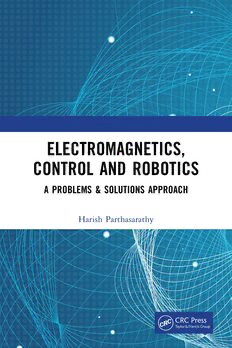
Electromagnetics, Control and Robotics: A Problems & Solutions Approach PDF
Preview Electromagnetics, Control and Robotics: A Problems & Solutions Approach
Electromagnetics, Control and Robotics A Problems & Solutions Approach Electromagnetics, Control and Robotics A Problems & Solutions Approach Harish Parthasarathy Professor Electronics & Communication Engineering Netaji Subhas Institute of Technology (NSIT) Harish Parthasarathy New Delhi, Delhi-110078 Firstpublished2023 byCRCPress 4ParkSquare,MiltonPark,Abingdon,Oxon,OX144RN andbyCRCPress 6000BrokenSoundParkwayNW,Suite300,BocaRaton,FL33487-2742 ©2023HarishParthasarathyandManakinPress CRCPressisanimprintofInformaUKLimited TherightofHarishParthasarathytobeidentifiedasauthorofthisworkhasbeenassertedin accordancewithsections77and78oftheCopyright,DesignsandPatentsAct1988. Allrightsreserved.Nopartofthisbookmaybereprintedorreproducedorutilisedinany formorbyanyelectronic,mechanical,orothermeans,nowknownorhereafterinvented, includingphotocopyingandrecording,orinanyinformationstorageorretrievalsystem, withoutpermissioninwritingfromthepublishers. Forpermissiontophotocopyorusematerialelectronicallyfromthiswork,accesswww. copyright.comorcontacttheCopyrightClearanceCenter,Inc.(CCC),222RosewoodDrive, Danvers,MA01923,978-750-8400.ForworksthatarenotavailableonCCCpleasecontact [email protected] Trademarknotice:Productorcorporatenamesmaybetrademarksorregisteredtrademarks, andareusedonlyforidentificationandexplanationwithoutintenttoinfringe. PrinteditionnotforsaleinSouthAsia(India,SriLanka,Nepal,Bangladesh,Pakistanor Bhutan). BritishLibraryCataloguing-in-PublicationData AcataloguerecordforthisbookisavailablefromtheBritishLibrary ISBN:9781032384337(hbk) ISBN:9781032384351(pbk) ISBN:9781003345046(ebk) DOI:10.1201/9781003345046 TypesetinArial,MinionPro,Symbol,CalisMTBold,TimesNewRoman,RupeeForadian, Wingdings,ZapDingbats,Euclid,MT-Extra byManakinPress,Delhi Preface This book is a research monograph covering a variety of problems in statistical state and parameter estimation in nonlinear stochastic dynamical system in both the classical and quantum scenario, propagation of electromagnetic waves in a plasma described by the Boltzmann Kinetic Transport Equation, Classical and Quantum General Relativity etc. It will be of use to Engineering undergraduate students interested in analysing the motion of robots subject to random perturbation. It will also be very useful for research scientists working in Quantum Filtering and studying problems of inhomogeneous perturbation to in a homogeneous and isotropic universe leading to the formation of galaxies in an expanding universe. The mathematical prerequisite for studying this book include Ordinary and Partial Differential Equations, Riemannian Geometry, Stochastic Calculus of Brownian Motion and Poisson Processes, Perturbation Theory of Dynamical System, Group Theory and Group Representation Theory and Basic Operator Theory Especially in the Boson Fock Space as formulated by R.L. Hudson & K.R. Parthasarathy. Author v Table of Contents 1. Master-slave Robots, Optimal Control, Quantum Mechanics and Information 1–54 2. Quantum State Estimation Robot System Estimation, Rotation Matrix Estimation, Quantum Filtering 55–100 3. Quantum Field Theory, Gravitational and Electromagnetic Waves in Cosmology, Electromagnetics and Fluids, Quantum Gate Design 101–134 4. Brownian Motion and Levy Processes, Nonlinear Filtering Plasma Waves, Quantum Stochastics and Parameter Estimation 135–186 5. Quantum Gravity, Lie Groups in Robotics, Field of Robots, Quantum Robots, Quantum Transmission Lines, Quantum Optimal Control 187–216 6. Random Feedback Control, Group Invariants and Pattern Classification, Quantum Mechanics in Levy Noise, State Observer and Trajectory Tracking 217–250 7. Radon Transform for Rotation Estimation, Interaction Picture in Quantum Mechanics, Curvature Tensor in GTR, Gauge Fields 251–294 8. Spin-field Interaction, Viscous and Thermal Effects in GTR, Channel Capacity, Filtering and Control for Robots, Discrete Time Nonlinear Stochastic Filter 295–366 9. Quantum Filtering in Robotics, Information, Feynman Path Integrals, Levy Noise, Haar Measure on Groups, Gravity and Robots, Canonical Quantum Gravity, Langevin Equation, Antenna Current in a Field Dependent Medium 367–428 10. Perturbation Theory in Cosmology, Hamiltonian of Charged Particles in Curved Space-time, Brownian Local Time, Statistics of Quantum Observables,Quantization of Stochastic Dynamical Systems, Quantum Relative Entropy Evolution for Open Systems, Quantum Gates in Levy Noise 429–506 11. Wave Equation with Random Boundary, Robots in a Fluid, Cosmology with Stochastic Perturbations, Interaction Between Graviton, Photon and Electron- Positron Fields, Evans-Hudson Flows for Quantization of Stochastic Evolutions 507–608 12. Appendix 609–610 13. References 611–613 vii Master-slave Robots, Optimal Control, Quantum Mechanics and Information 1 [1] Basic Markov chain theory: Let X (t), t ≥ be a stochastic process on a probability space taking values in Z with the property P (X (t) ∈ B | X (τ) : τ ≤ s) = P (X (t) ∈ B | X(s)) for all B ⊂ Z and 0 ≤ s ≤ t. Then X (t) is called a Markov chain. It is completely characterized by the infinitesimal generator L = ((l )) where ab P (X (t + dt) = b| X(t) = a) = d + dt. l + 0 (dt) a, b ab Let P (t) = P (X(t) = a) a for some initial probability distribution of X (0) on Z. Then, the Chapman - Kolmogorov equation P′(t) = ∑P (t)λ a b ba b or equivalently, in terms of matrices. P′(t)T = P(t)T Λ which gives P(t)T = P(0)T exp (tL) Let 0 ≤ t1 < t2< ...< tp. Then for f : Z→ R, we have E(f(X(t1)...f(X(tp)) = P(0)T exp(t1L)Df.. exp((t – t )L)D...exp((t – t )L)Dfu 2 1 f p p–1 where Df = diag(f(a) : a ∈ Z) and u = [1,1,...]T Let T <T <...be the jump times of the Markov chain. Assume that X(0)=i . Then 1 2 0 for i ≠i , 1 0 P(T (t, t + dt], X(T +) = i P(T > t) l(i i )dt 1 1 1 1 0,1 Now, P(T >t + dt) = P(T > t) (1+l(i , i ) dt) 1 1 0 0 and hence P(T >t) = exp(tl(i i ) 1 0, 0 We are using the notation l(a, b) in place of l . Thus, we get the joint distribution ab of (T , X(T +)): 1 1 P(T ∈(t, t + dt),X(T +) = i ) = l(i , i ).exp(tl(i , i ))dt 1 1 1 0 1 0 0 Likewise, we get using the Markov property P(T ∈(t,t + dt), X (T +) = i |T ,(X (T +) = i ) n n n n – 1, n–1 n – 1 1
